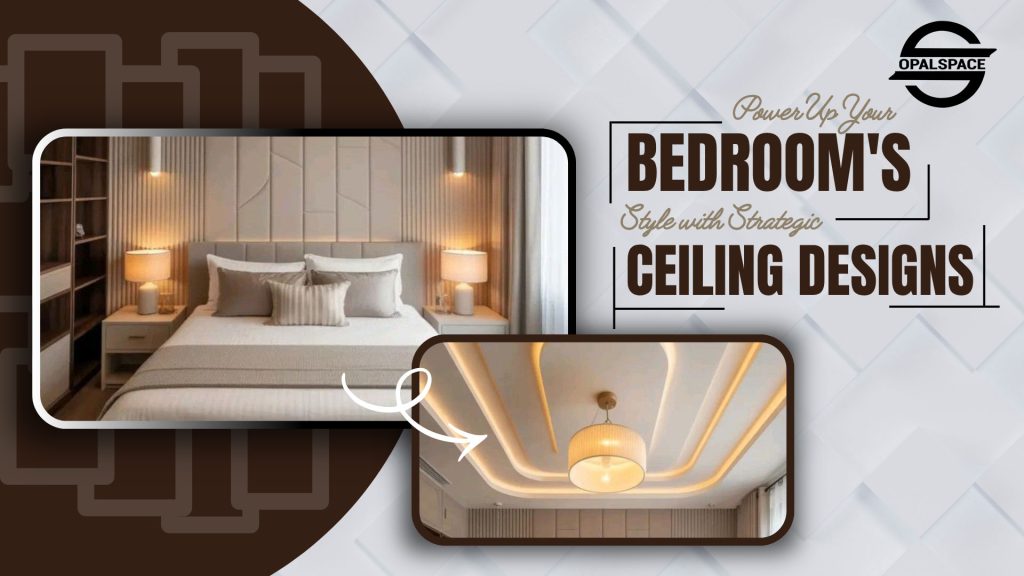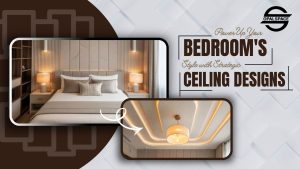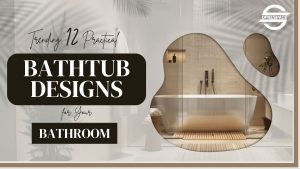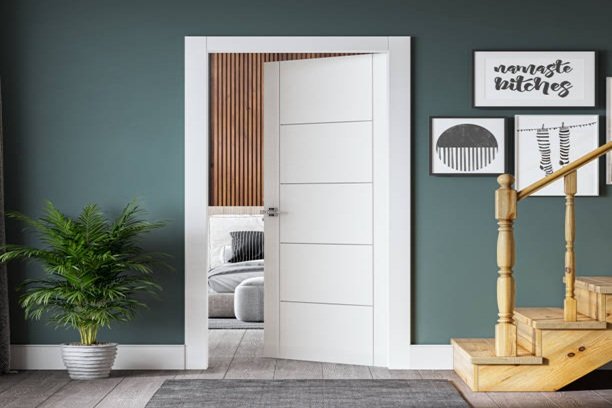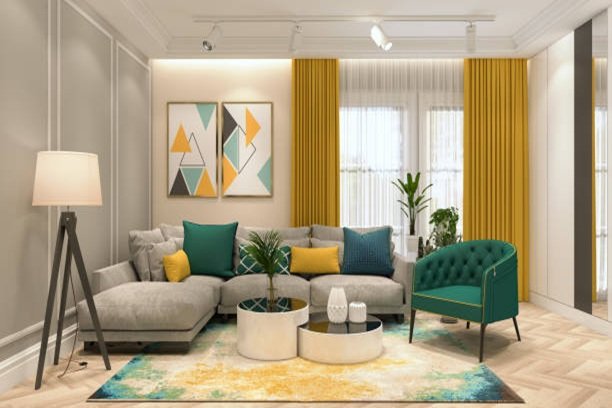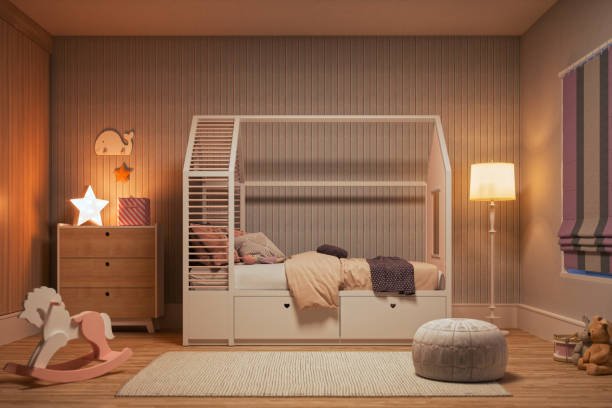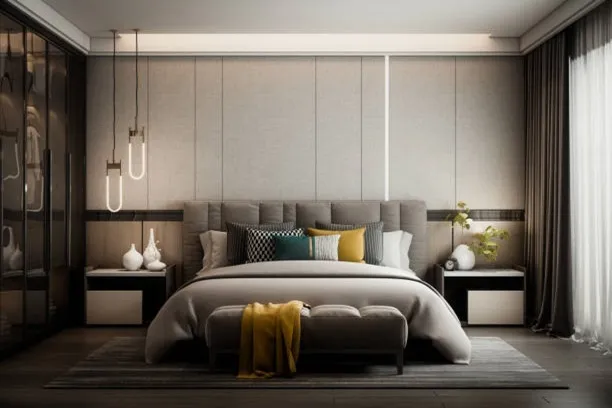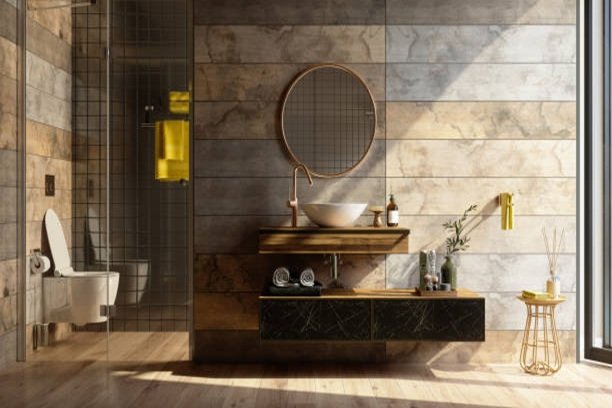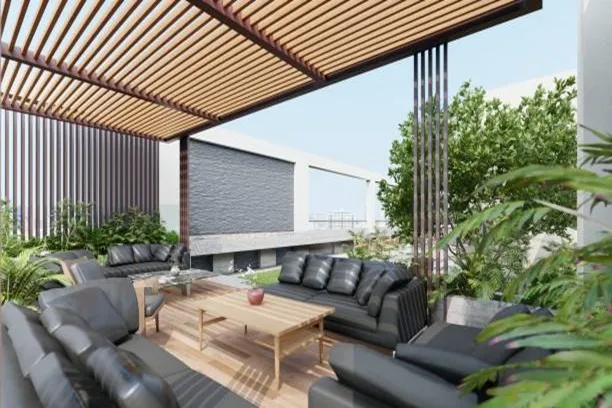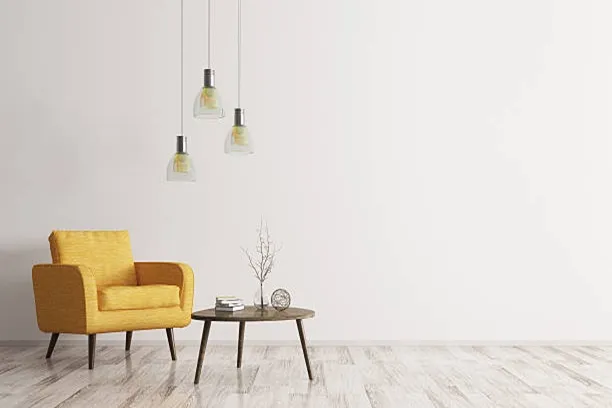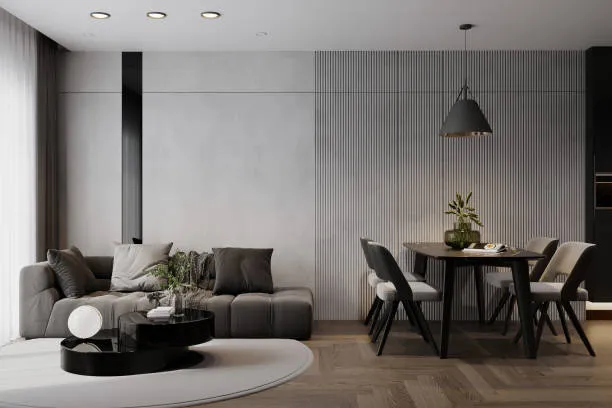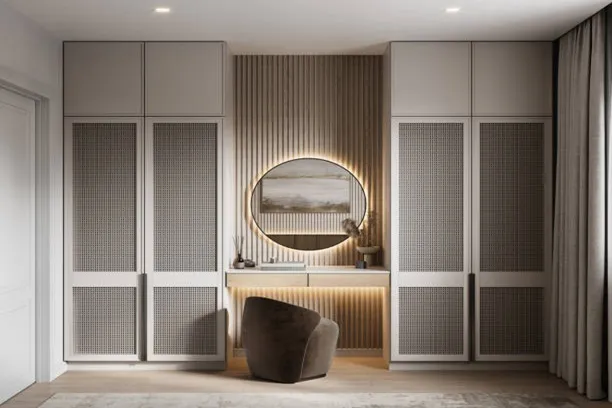Table of Contents
Bedroom ceiling has firmly established itself as a fundamental component in modern day home interior setup. No longer treated as an afterthought, it is now actively recognized for its power to define a room’s spirit, influence its perceived dimensions, and enhance its comfort. Modern bedroom ceiling designs, in particular, offer a sophisticated and streamlined approach to contemporary living. They provide the ideal framework for incorporating ambient and task lighting, easily housing climate control systems, and affirming the harmonious placement of essential fixtures like ceiling fans. This guide will explore the practical and aesthetic considerations of these designs to help you make an informed choice for your bedroom.
What are the best false ceiling designs ideas for a modern bedroom?
1. Bedroom POP Ceiling Design
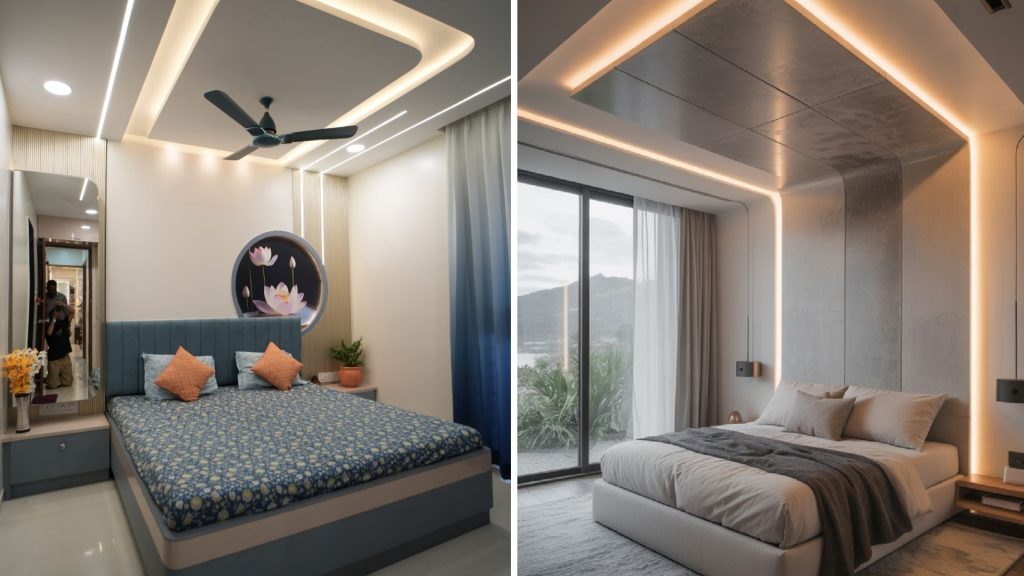
- POP, or Plaster of Paris, is a very fine powder that is mixed with water to create a smooth, putty-like material.
- Its biggest advantage is its flexibility; it can be moulded into almost any shape, allowing for intricate curves, arches, and detailed patterns that are hard to achieve with other materials.
- It provides a perfectly seamless and smooth finish with no visible joints, which is ideal for a high-end, polished look.
- However, the installation is a multi-step, labour-intensive process involving skilled craftsmanship, making it generally more time-consuming than other options.
- It’s important to note that POP is not inherently moisture-resistant, so it may not be the best choice for humid climates or rooms prone to dampness without proper treatment.
- While great for custom designs, it is a more permanent solution, and making changes or accessing the ceiling void later can be difficult and messy.
- Despite newer materials, POP remains a popular choice for those seeking classic, ornate, or highly customized ceiling designs.
2. Gypsum False Ceiling Design for Bedroom
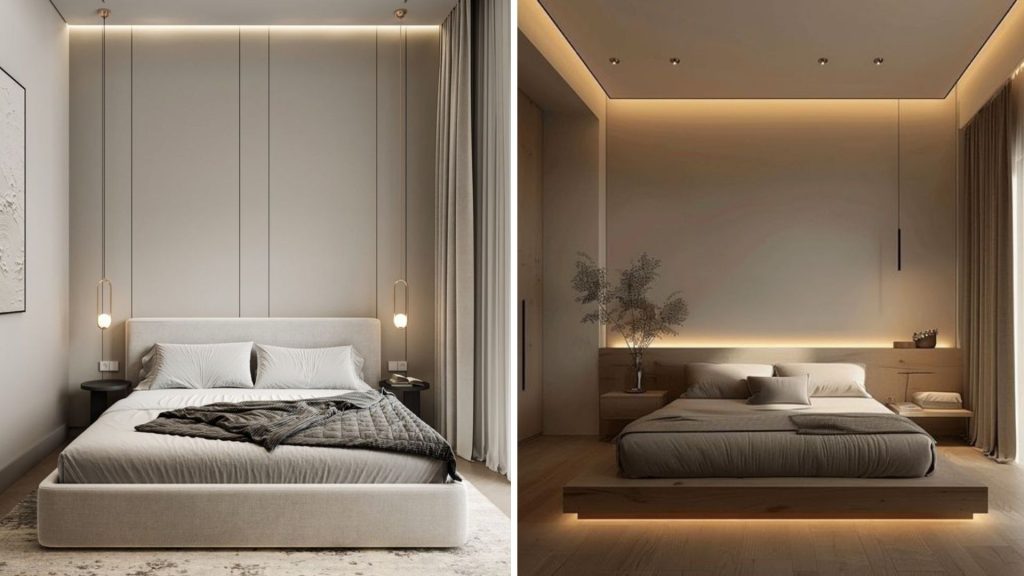
- Gypsum ceilings are made from prefabricated boards or panels that are screwed onto a metal frame, making the installation process much quicker and cleaner than POP.
- These boards are naturally fire-resistant, adding a valuable layer of safety to your home, which is a key reason for their widespread use.
- Like POP, gypsum can be used to create a variety of designs, including multiple levels, but it is especially well-suited for modern, geometric shapes with sharp, clean lines.
- The surface is ready for painting immediately after the joints are taped and finished, allowing you to choose any colour you want for your ceiling.
- Gypsum boards are also known for their sound-absorbing qualities, which can help make your bedroom quieter and more peaceful.
- This is a durable and stable material that is less likely to crack over time compared to traditional POP, provided it is installed correctly.
- It offers an excellent balance of modern performance, design flexibility, and safety, making it one of the most practical choices for a contemporary bedroom.
3. Bedroom PVC Ceiling Design
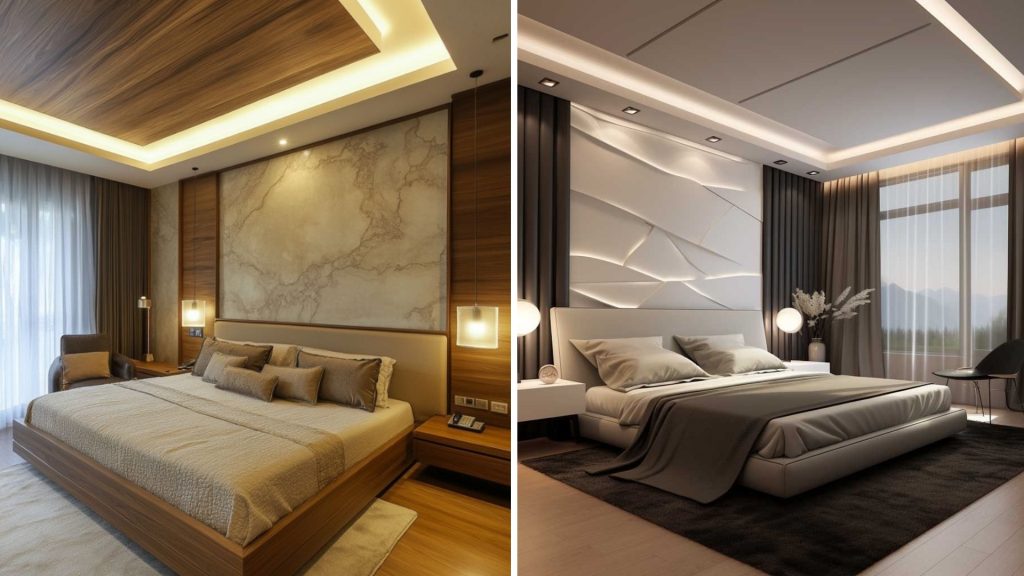
- PVC ceilings are made from lightweight plastic panels that are either clipped or screwed onto a frame, and they are one of the most budget-friendly false ceiling options.
- Their most significant benefit is their high resistance to moisture and humidity, making them ideal for bedrooms in coastal areas or places with damp weather.
- These panels are very easy to maintain; a simple wipe with a damp cloth is usually all that’s needed to keep them clean, and they are not prone to termites or rot.
- While available in various finishes that mimic wood or are plain white, the design options are more limited compared to the seamless look of gypsum or POP.
- Because they are installed panel-by-panel, the joints between them are often visible, which can detract from a truly seamless, high-end aesthetic.
- PVC is not as environmentally friendly as gypsum or wood, and it may not feel as premium to the touch, but it excels in functionality for specific, moisture-prone needs.
4. Wooden Ceiling Designs for Bedrooms
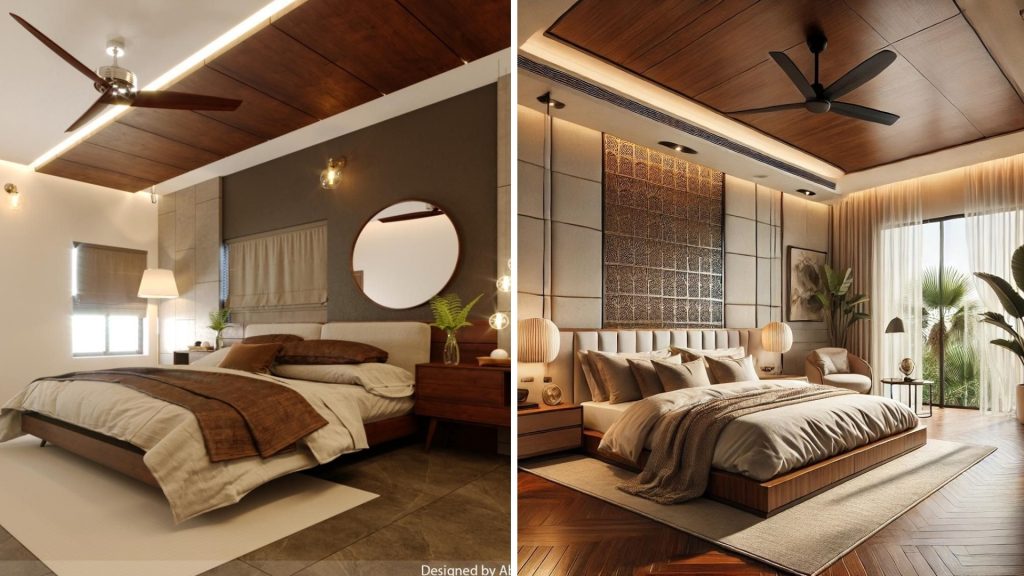
- Wooden ceilings bring instant warmth, texture, and a natural, organic feel to a bedroom, creating a warm and inviting atmosphere.
- You can use solid wood planks, engineered wood, or even wood-look veneers on gypsum boards, depending on your budget and the look you want to achieve.
- This material is incredibly versatile, working well with a range of styles from rustic and farmhouse to sleek and modern, especially with polished, dark wood finishes.
- Proper installation is crucial to allow for the natural expansion and contraction of the wood with changes in temperature and humidity, preventing warping.
- Wood requires a bit more maintenance than other materials; it may need periodic polishing or sealing to protect its finish and maintain its appearance over time.
- While generally more expensive than basic gypsum or PVC, the unique character and timeless appeal of a wood ceiling can significantly elevate the design of a master bedroom.
5. Bedroom Ceiling Design with Fan
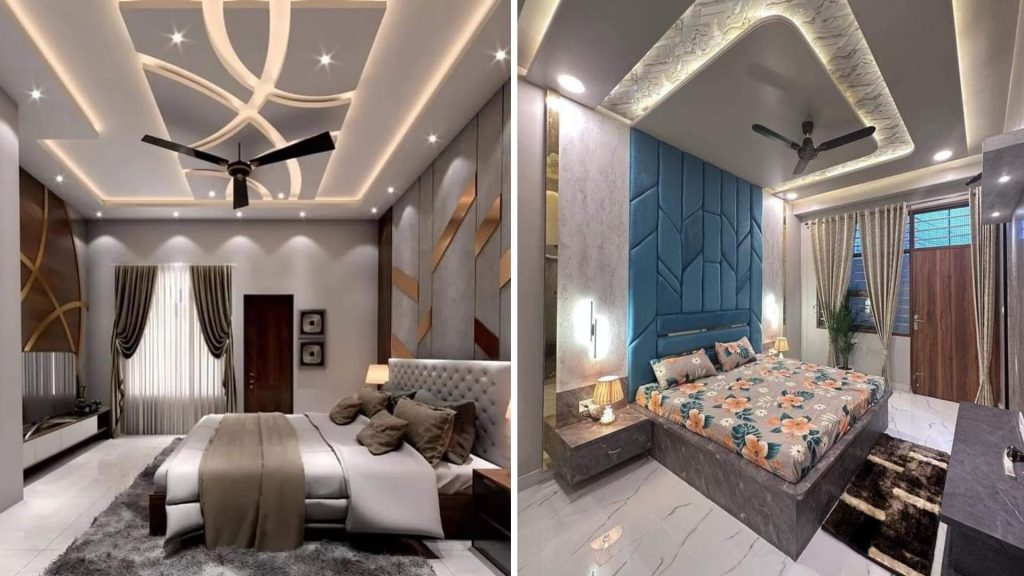
- The most straightforward and effective solution is to design a central recessed panel or a ‘tray’ that houses the fan, ensuring it hangs at a safe and functional height.
- Always decide on the fan’s location and size before finalizing the ceiling design to ensure the structural frame can properly support its weight and movement.
- For lower ceilings, a simple, single-level false ceiling with a slight drop around the fan’s mounting point can create a defined look without sacrificing too much height.
- Make sure there is a sufficient gap (at least 12-18 inches) between the fan blades and the surrounding ceiling to allow for proper air circulation and prevent a cramped feel.
- You can integrate cove or recessed lighting around the central fan panel to provide ample ambient light without cluttering the ceiling with multiple fixtures.
- For a cohesive look, choose a fan whose finish (e.g., matte black, brushed nickel, wood) complements the other elements in the room, like your light fixtures and hardware.
6. Bedroom Ceiling Light Design
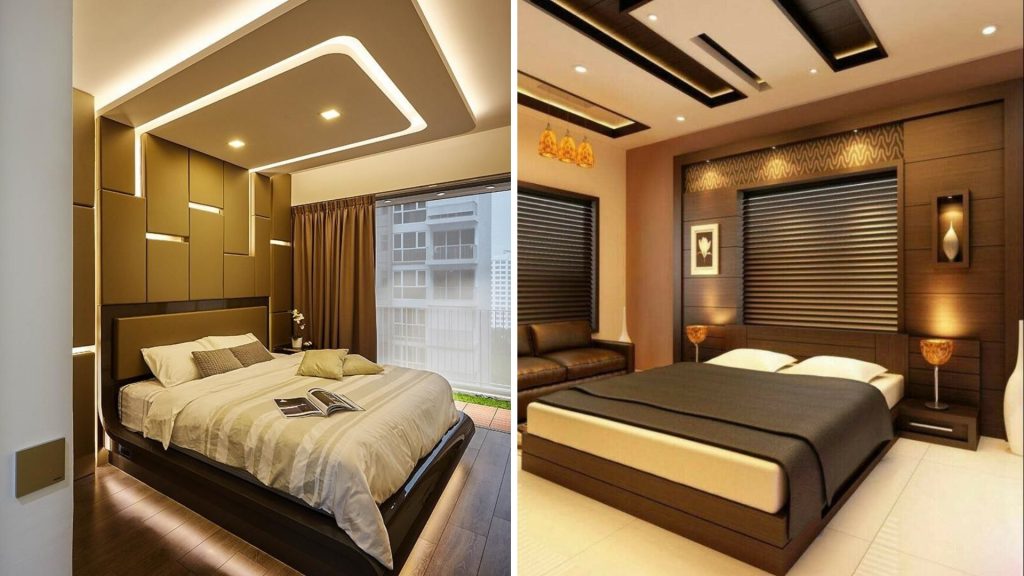
- Cove lighting, where LED strips are hidden in a recessed ledge, is a popular way to create soft, indirect ambient light that makes the room feel larger and more serene.
- Small, recessed downlights (or ‘spotlights’) can be strategically placed to provide focused task lighting for reading nooks or to highlight artwork, without being obtrusive.
- A statement pendant light or a cluster of pendant lights works beautifully over a bedside area or in the center of the room, serving as a stunning visual focal point.
- For a truly modern look, consider minimalist LED profiles that create sharp lines of light on the ceiling, adding an architectural element to the space.
- The most effective lighting plans use a combination of these types, ambient, task, and accent, to make the room functional and visually appealing at any time of day.
- Always plan the wiring and placement of all lights during the ceiling framing stage to avoid the need for messy alterations later on.
7. Small Bedroom Ceiling Design
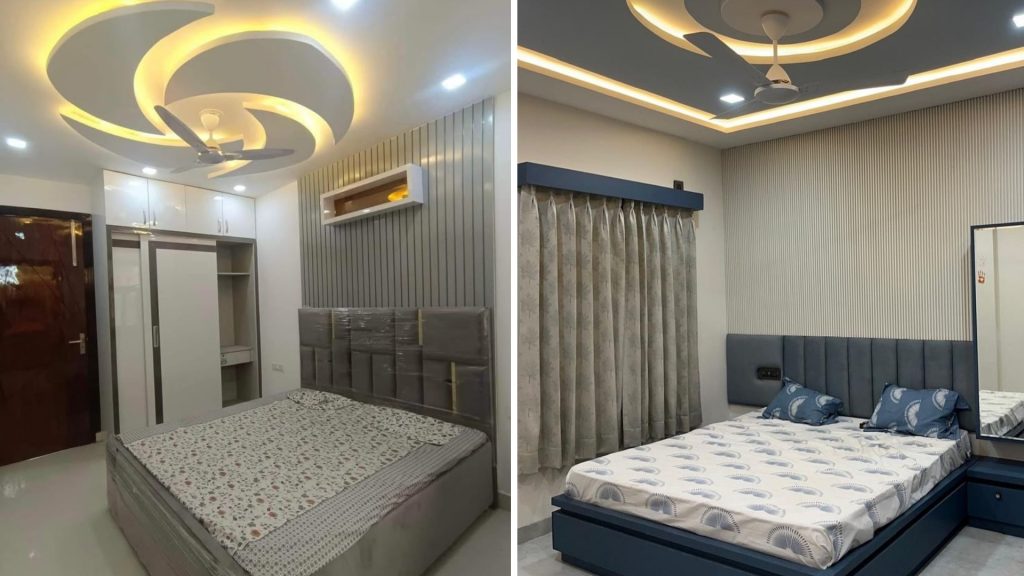
- The golden rule for a low ceiling is to avoid complicated, multi-level designs that drop down too far, as they will make the room feel cramped and boxy.
- Opt for a simple, single-layer false ceiling with a slim profile, or even just a cove lighting detail around the perimeter, which draws the eye upwards.
- Using glossy or high-gloss paint on the ceiling can help reflect light and create an illusion of more height and space.
- Stick to light, neutral colours for both the ceiling and walls, as dark colours tend to absorb light and make a small room feel even smaller.
- Ensure that any central fixture, like a fan or light, is flush-mounted or has a very low profile to maintain as much headroom as possible.
8. Master Bedroom False Ceiling Design
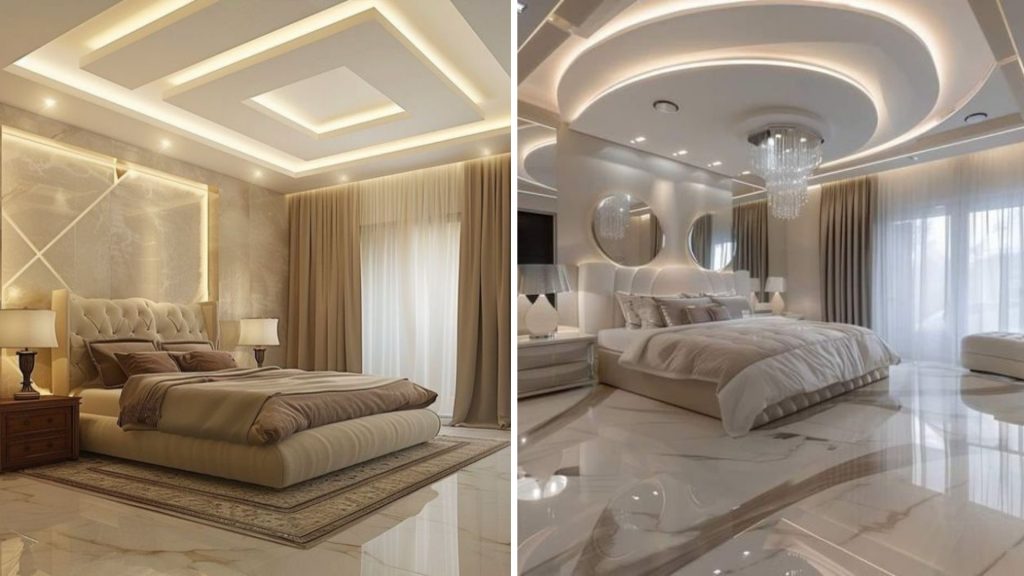
- A master bedroom offers the space to experiment with more dramatic designs, such as a large, central tray ceiling that creates a grand and defined sleeping area.
- You can incorporate two or more ceiling levels to add depth and dimension, using strategic lighting on each level to enhance the dramatic effect.
- This is the place to consider more luxurious materials or combinations, like a gypsum structure with a central wooden inlay, to add texture and sophistication.
- A master bedroom is an ideal space to create a “star-gazing” ceiling by embedding tiny fiber optic lights within a dark-coloured ceiling to mimic a night sky.
- The design can be used to subtly zone the large room, with one ceiling style over the bed and another over a sitting or dressing area.
- Since it’s a personal retreat, you can personalize the design with unique patterns, curves, or motifs that reflect your personal style, making it a true sanctuary.
9. Simple Bedroom Ceiling Designs
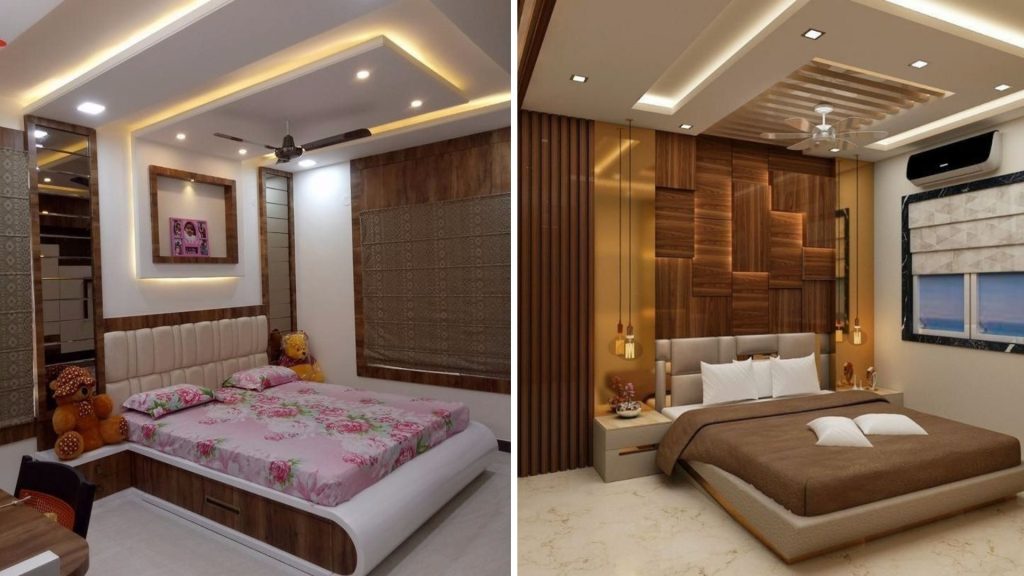
- A simple false ceiling doesn’t have to be plain; a single, sleek layer with a cove for hidden LED lights can look incredibly modern and elegant with minimal effort.
- Consider a basic geometric pattern, like a single square or rectangular frame in the center of the ceiling, which adds definition without being overwhelming.
- Sometimes, the simplest solution is the best: a freshly plastered and painted ceiling with a few well-placed, minimalist recessed downlights is clean and timeless.
- Using a slightly different shade of white or a very light neutral colour on the ceiling than on the walls can create a subtle, sophisticated contrast.
- The goal is to enhance the room’s aesthetics and lighting without the design itself becoming the main focus, keeping the space feeling calm and uncluttered.
- This approach is often the most cost-effective, uses less material, and is quicker to install, while still providing a significant upgrade to the room’s overall feel.
How Can We Help You?
Today’s interior solutions leverage the ceiling as a strategic design surface to integrate technology, optimize lighting, and tying the aesthetic together. We hope this guide has illuminated how the right ceiling can transform your bedroom, turning overhead space into a core feature of your comfort and style. This same principle of intentional, holistic design applies to every corner of your home. If you are ready to bring this cohesive vision to life, from a single modern false ceiling to a complete home interior transformation, our team is here to provide expert guidance and flawless execution for a unified and beautifully functional living space.
FAQs
1. What is a false ceiling design for a bedroom?
A false ceiling, also known as a dropped ceiling, is a secondary layer installed below your main structural ceiling. It is created using a metal frame that is then covered with materials like gypsum, POP, or PVC boards. The primary purpose is to enhance the room's aesthetics by creating a smooth, modern look. It also has functional benefits like hiding electrical wires, pipes, and air conditioning ducts while improving light and acoustics.
2. What is the difference between a Bedroom POP Ceiling Design and a Gypsum false ceiling design?
POP (Plaster of Paris) is a powder mixed with water to form a paste that can be molded into seamless, intricate curves and designs on-site, offering a highly customized look. Gypsum, on the other hand, comes as pre-manufactured boards that are fixed to a metal frame, making installation faster and cleaner. Gypsum is naturally fire-resistant and less prone to cracking, while POP requires skilled labor for its hand-applied, sculptural finish. Both provide an excellent base for painting and lighting.
3. Which material is better for a humid climate, POP or a Bedroom PVC Ceiling Design?
For a humid climate, a PVC ceiling design is a more practical and durable choice. PVC is a plastic-based material that is completely resistant to moisture, preventing issues like mold, warping, or staining. While POP and gypsum can be used, they may require special moisture-resistant treatments and paints to withstand damp conditions. PVC is a lightweight, low-maintenance option that can be easily wiped clean, making it ideal for areas with high humidity.
4. Can I have a Bedroom Ceiling Design with a Fan if I have low ceilings?
Yes, you can integrate a fan with a false ceiling even in a room with low height. The best approach is to opt for a simple, single-layer false ceiling that has a minimal drop. The fan should be mounted directly to the concrete slab above, with a hole in the false ceiling for the rod to pass through. This ensures the fan is securely anchored. It is crucial to plan this with your contractor early on to ensure structural support and adequate clearance for safe operation.
5. How can a Small Bedroom Ceiling Design make my room look bigger?
A well-planned ceiling can create a powerful illusion of space in a small bedroom. Using a simple, single-layer false ceiling with cove lighting that casts an upward glow can make the ceiling appear to float, adding visual height. Choosing light, reflective colors and a glossy finish helps bounce light around the room. Avoiding complex, multi-level designs that drop down too far is key, as they can make the room feel cramped and boxy.
6. What are some Simple Bedroom Ceiling Designs that are still stylish?
Simple bedroom ceiling designs focus on clean lines and integrated lighting rather than complex shapes. A very effective and popular simple design is a flat gypsum ceiling with a cove or recessed groove around the perimeter for hidden LED strips. This creates a soft, ambient glow that defines the space without clutter. Another option is a basic tray ceiling, which is a central recessed panel that adds depth and is perfect for highlighting a central light fixture.
7. What should I consider for a Master Bedroom False Ceiling Design?
A master bedroom offers more space for a grander statement. You can consider a multi-level tray ceiling to add significant depth and dimension, often with different lighting on each level for ambiance. Incorporating material contrasts, like a gypsum structure with a central wooden inlay, adds warmth and texture. The design can also be used to zone the large room, defining the sleeping area from a sitting area with a different ceiling treatment.

